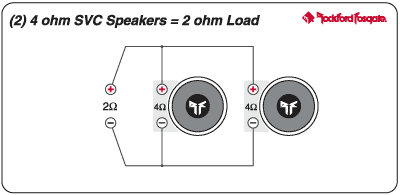

Otherwise, there isnt much difference between the sound.Speakers Impedance The Difference Between 2 ohm and 4-ohm Car SpeakersThe ohm is defined as an electrical resistance between two points of a conductor when a constant potential difference of one volt, applied to these points, produces in the conductor a current of one ampere, the conductor not being the seat of any electromotive force. But if the power handling is 100 watts, then the max SPL would be 120dB in either case.In truth, if you are an audio expert, you might notice the change in sound quality. The 8 ohm would be pulling 1 watt and the 4 ohm would be pulling 2 watts. Then the 4 ohm would produce 103dB with the same input voltage.
Electrical units so defined were not a coherent system with the units for energy, mass, length, and time, requiring conversion factors to be used in calculations relating energy or power to resistance. Resistance was often expressed as a multiple of the resistance of a standard length of telegraph wires different agencies used different bases for a standard, so units were not readily interchangeable. Telegraphers and other early users of electricity in the 19th century needed a practical standard unit of measurement for resistance. Where alternating current is applied to the circuit (or where the resistance value is a function of time), the relation above is true at any instant but calculation of average power over an interval of time requires integration of "instantaneous" power over that interval.Since the ohm belongs to a coherent system of units, when each of these quantities has its corresponding SI unit ( watt for P, ohm for R, volt for V and ampere for I, which are related as in § Definition, this formula remains valid numerically when these units are used (and thought of as being cancelled or omitted).The rapid rise of electrotechnology in the last half of the 19th century created a demand for a rational, coherent, consistent, and international system of units for electrical quantities. Non-linear resistors have a value that may vary depending on the applied voltage (or current).

These units had the great advantage of simplifying the equations used in the solution of electromagnetic problems, and eliminated conversion factors in calculations about electrical quantities. Some early definitions of a unit of resistance, for example, defined a unit resistance as one quadrant of the Earth per second.The absolute-units system related magnetic and electrostatic quantities to metric base units of mass, time, and length. It is desirable that one unit of electrical potential will force one unit of electric current through one unit of electrical resistance, doing one unit of work in one unit of time, otherwise, all electrical calculations will require conversion factors.Since so-called "absolute" units of charge and current are expressed as combinations of units of mass, length, and time, dimensional analysis of the relations between potential, current, and resistance show that resistance is expressed in units of length per time – a velocity.
The BAAS in 1861 appointed a committee including Maxwell and Thomson to report upon standards of electrical resistance. Not all users of units had the resources to carry out metrology experiments to the required precision, so working standards notionally based on the physical definition were required.In 1861, Latimer Clark (1822–1898) and Sir Charles Bright (1832–1888) presented a paper at the British Association for the Advancement of Science meeting suggesting that standards for electrical units be established and suggesting names for these units derived from eminent philosophers, 'Ohma', 'Farad' and 'Volt'. One proposal was to devise a unit based on a mercury column that would be coherent – in effect, adjusting the length to make the resistance one ohm. However, this unit was not coherent with other units. He proposed a column of pure mercury, of one square millimeter cross section, one metre long: Siemens mercury unit. In 1860 Werner Siemens (1816–1892) published a suggestion for a reproducible resistance standard in Poggendorffs Annalen der Physik und Chemie.
The error was significant for preparation of working standards.On 21 September 1881 the Congrès internationale des électriciens (international conference of electricians) defined a practical unit of ohm for the resistance, based on CGS units, using a mercury column 1 sq. Ohm was intended to be 10 9 CGS units but owing to an error in calculations the definition was 1.3% too small. By 1867 the unit is referred to as simply ohm. In the third report of the committee, 1864, the resistance unit is referred to as "B.A.
System of electromagnetic units. The unit was based upon the ohm equal to 10 9 units of resistance of the C.G.S. The "international" ohm was recommended by unanimous resolution at the International Electrical Congress 1893 in Chicago. Although called "legal", this standard was not adopted by any national legislation. Unit (equivalent to 104.7 cm), the Siemens unit (100 cm by definition), and the CGS unit.
Advances in metrology allowed definitions to be formulated with a high degree of precision and repeatability.Historical units of resistance Unit 100 million ft/s (30,480 km/s), considered obsolete even in 1884A specified copper wire 25 ft (7.620 m) long weighing 345 gr (22. Definitions would change with little effect on commercial uses of the units. The mercury column standard was maintained until the 1948 General Conference on Weights and Measures, at which the ohm was redefined in absolute terms instead of as an artifact standard.By the end of the 19th century, units were well understood and consistent. In 1908, this definition was adopted by scientific representatives from several countries at the International Conference on Electric Units and Standards in London. This definition became the basis for the legal definition of the ohm in several countries.


 0 kommentar(er)
0 kommentar(er)
